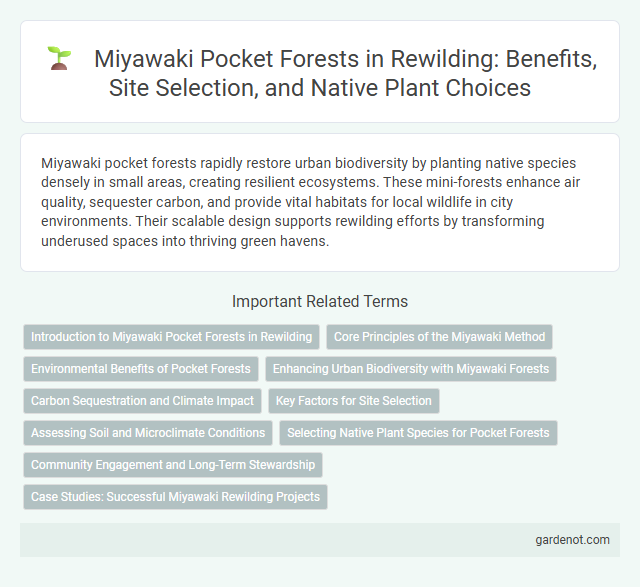Miyawaki pocket forests rapidly restore urban biodiversity by planting native species densely in small areas, creating resilient ecosystems. These mini-forests enhance air quality, sequester carbon, and provide vital habitats for local wildlife in city environments. Their scalable design supports rewilding efforts by transforming underused spaces into thriving green havens.
Introduction to Miyawaki Pocket Forests in Rewilding
Miyawaki pocket forests are a revolutionary approach to urban rewilding, designed to restore native biodiversity in compact spaces using dense, multilayered planting of indigenous trees. This technique accelerates forest growth up to ten times faster than conventional methods, creating resilient ecosystems that support wildlife and improve air quality. Implementing Miyawaki forests in cities transforms underutilized land into vibrant green pockets, fostering ecological balance and community well-being.
Core Principles of the Miyawaki Method
The Miyawaki method emphasizes planting native species densely to create self-sustaining, biodiverse pocket forests that regenerate rapidly. Soil preparation involves enriching the ground with organic matter and promoting beneficial microbial activity, fostering strong root systems. Minimal human intervention after planting ensures natural growth patterns, maximizing ecological resilience and carbon sequestration.
Environmental Benefits of Pocket Forests
Miyawaki pocket forests significantly enhance urban biodiversity by creating dense, native vegetation that supports various bird, insect, and animal species. These forests improve air quality by absorbing pollutants and sequestering carbon dioxide, contributing to climate change mitigation. They also aid in regulating temperature and reducing urban heat island effects, thus promoting healthier and more sustainable urban environments.
Enhancing Urban Biodiversity with Miyawaki Forests
Miyawaki pocket forests significantly enhance urban biodiversity by rapidly growing dense, native vegetation that supports diverse flora and fauna within compact city spaces. These forests create microhabitats for pollinators, birds, and beneficial insects, fostering resilient ecosystems amidst urban landscapes. The Miyawaki method promotes soil health and carbon sequestration, contributing to sustainable urban environmental management.
Carbon Sequestration and Climate Impact
Miyawaki pocket forests enhance carbon sequestration by rapidly growing dense native vegetation, capturing significant amounts of CO2 and reducing urban heat. These compact forests promote biodiversity while improving air quality, contributing to local climate regulation and mitigating the urban heat island effect. Their accelerated growth rates enable quicker carbon storage compared to traditional afforestation methods, playing a vital role in urban climate resilience.
Key Factors for Site Selection
Key factors for selecting a site for a Miyawaki pocket forest include soil quality, sunlight availability, and local biodiversity levels. Optimal soil conditions with good drainage and rich organic matter enhance seedling growth, while adequate sunlight exposure ensures healthy photosynthesis. Proximity to existing green spaces and native species availability are crucial for promoting a resilient and sustainable mini-ecosystem.
Assessing Soil and Microclimate Conditions
Assessing soil and microclimate conditions is critical in the Miyawaki pocket forest method to ensure optimal tree growth and biodiversity restoration. Soil texture, pH levels, and nutrient content are analyzed to select suitable native species and enhance soil fertility through organic amendments. Microclimate factors such as temperature, humidity, and sunlight exposure are monitored to create a resilient, self-sustaining mini-ecosystem that supports diverse flora and fauna.
Selecting Native Plant Species for Pocket Forests
Selecting native plant species for Miyawaki pocket forests ensures rapid growth and biodiversity support by mimicking natural forest ecosystems. Native species adapt better to local climate and soil conditions, promoting soil health and attracting indigenous wildlife. Careful selection enhances ecosystem resilience and accelerates carbon sequestration in urban environments.
Community Engagement and Long-Term Stewardship
Miyawaki pocket forests foster community engagement by involving local residents in planting native species, cultivating a shared sense of ownership and environmental responsibility. These dense, fast-growing mini-forests require ongoing long-term stewardship, with volunteers regularly monitoring growth and maintaining biodiversity to ensure ecosystem resilience. This collaborative approach enhances urban green spaces, promotes ecological education, and supports sustainable rewilding efforts.
Case Studies: Successful Miyawaki Rewilding Projects
The Miyawaki pocket forest technique has transformed urban spaces worldwide by creating dense, native forests that rapidly restore biodiversity and improve air quality within a few years. Notable case studies include the Nishiyama Forest in Japan, where native species planted in small plots increased local bird and insect populations significantly, and the Mumbai rewilding project in India, which rejuvenated barren urban lands into vibrant ecosystems supporting diverse flora and fauna. These successful projects demonstrate how the Miyawaki method accelerates ecological restoration, enhances urban resilience, and fosters community engagement in rewilding efforts.
Miyawaki pocket forest Infographic

 gardenot.com
gardenot.com